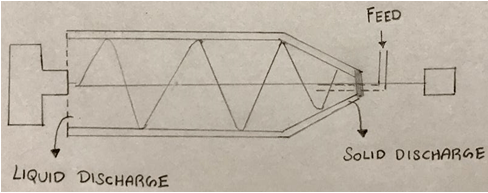This set of Food Processing Unit Operations Multiple Choice Questions & Answers (MCQs) focuses on “Mechanical Separation – Centrifugation Equipment”.
1. What is maximum speed of low speed centrifuge?
a) 1000-2000rpm
b) 3000-4000rpm
c) 4000-5000rpm
d) 5000-6000rpm
View Answer
Explanation: Most laboratories have a low-speed centrifuge used for routine sedimentation of heavy particles and the low-speed centrifuge has a maximum speed of 4000-5000rpm.
2. Which of the following used for sedimentation of red blood cells?
a) Low speed centrifuge
b) High speed centrifuge
c) Ultra centrifuge
d) Vacuum centrifuge
View Answer
Explanation: Low speed centrifuge is used for sedimentation of red blood cells until the particles are tightly packed into a pellet and supernatant is separated by decantation.
3. What is maximum speed of high speed centrifuge?
a) 10000-20000rpm
b) 15000-20000rpm
c) 30000-50000rpm
d) 50000-60000rpm
View Answer
Explanation: High-speed centrifuges are used in biochemical applications. The high-speed centrifuge has a maximum speed of 15,000 – 20,000 RPM.
4. What are factors that affect high-speed centrifuges?
a) Speed and temperature
b) Pressure and temperature
c) Concentration and speed
d) Pressure and speed
View Answer
Explanation: High-speed centrifuges are used in biochemical applications, the factors that affect are higher speeds and temperature control of the rotor chamber.
5. Which of the following statements about ultracentrifugeare correct?
Statement 1: Ultracentrifuge has a maximum speed of 85,000 RPM.
Statement 2: It is used for both preparative work and analytical work.
a) True, False
b) True, True
c) False, True
d) False, False
View Answer
Explanation: Ultracentrifuge has a maximum speed of 65,000 RPM. Intense heat is generated due to high speed thus the spinning chambers must be refrigerated and kept at a high vacuum. It is used for both preparative work and analytical work.
6. Identify the type of centrifuge equipment.

a) Horizontal bowl scroll discharge
b) Longitudinal bowl scroll discharge
c) Vertical bowl scroll discharge
d) Latitude bowl scroll discharge
View Answer
Explanation: In horizontal bowl scroll discharge, centrifugal forces cause immediate sedimentation of the solids on the wall of bowl. The conveyor rotates in the same direction as the bowl, but at different speed, thus moving the solids near the conical end of the bowl.
7. Which industry uses centrifuge test?
a) Sugar industry
b) Oil industry
c) Bakery industry
d) Salt industry
View Answer
Explanation: Oil industries uses centrifuge test. A Centrifuge test is a fully programmable process which allows automatic configuration of specified oil test parameters.
8. What is the other name for screen centrifuge?
a) Low speed centrifuge
b) High speed centrifuge
c) Ultra centrifuge
d) Conveyor discharge centrifuge
View Answer
Explanation: Screen centrifuge is also known as worm screen or conveyor discharge centrifuge. It is widely used for the separation of crystalline, granular or fibrous materials from a solid-liquid mixture.
9. Which centrifuge used for separating caffeine?
a) Low speed centrifuge
b) Peeler centrifuge
c) Ultra centrifuge
d) Conveyor discharge centrifuge
View Answer
Explanation: Peeler centrifuge is used for separating caffeine. The peeler centrifuge has rotating filtration basket connected in at axis. The principle of centrifugal force is to separate solids from liquids by density difference.
10. What is the fixed angle of rotors in centrifuge?
a) 10° and 20°
b) 14° and 40°
c) 20° and 40°
d) 34° and 48°
View Answer
Explanation: In fixed angles, the tubes are fixed at angle between 14° and 40° to the vertical. Under the influence of centrifugation particles move radially outward and have short distance to travel before colliding withthe outer wall of the centrifuge tube.
Sanfoundry Global Education & Learning Series – Food Processing Unit Operations.
To practice all areas of Food Processing Unit Operations, here is complete set of 1000+ Multiple Choice Questions and Answers.
If you find a mistake in question / option / answer, kindly take a screenshot and email to [email protected]
- Check Food Processing Unit Operations Books
- Apply for Agricultural Engineering Internship
- Practice Agricultural Engineering MCQs
- Check Agricultural Engineering Books
